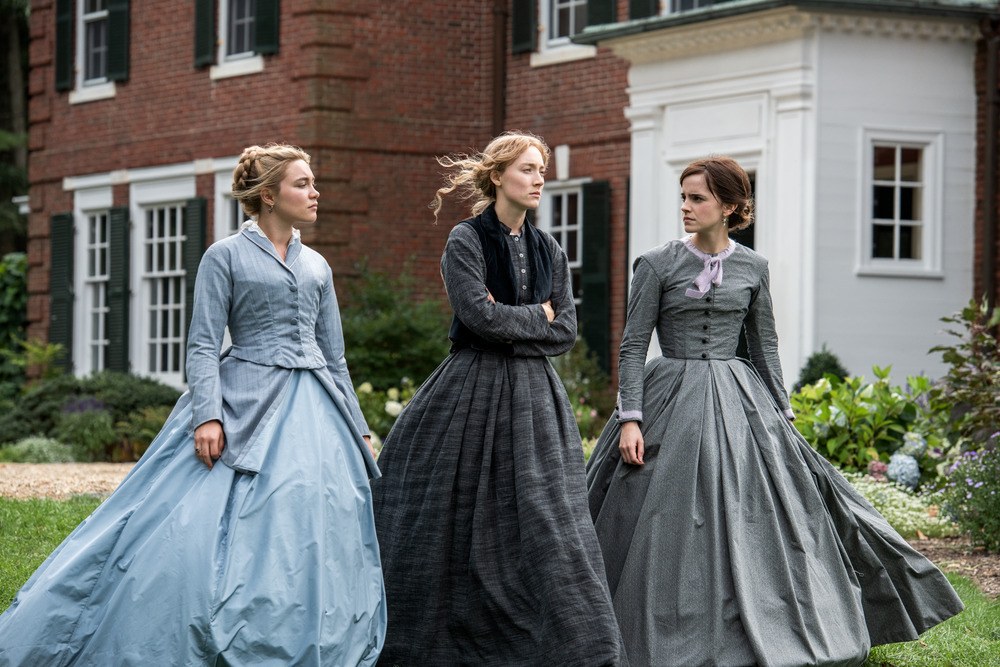Little Women

Florence Pugh, Saoirse Ronan and Emma Watson in Greta Gerwig's LITTLE WOMEN.
Since its initial publication in 1868, Louisa May Alcott’s LITTLE WOMEN inspired seven big-screen adaptations. Hailed as a landmark in Young Adult literature, it paved the way for works intended to help adolescents grapple with questions of morality, work ethic, and gender roles. Seen from our vantage point, it appears outdated—particularly in terms of its narrow focus on a genteel, lower-class white family—but its overarching theme of the fraught transition into adulthood remains universal.
The four March girls were loosely-based upon Alcott and her three sisters. Each represents a familiar archetype of womanhood: the universal beauty as domestic ideal, the hot-headed tomboy raging against cultural expectation, the gentle peacemaker content with a meek existence, and the oft-indulged artist yearning to be an aristocrat.
Subtly modernized, writer/director Greta Gerwig’s adaptation follows a non-chronological narrative. The film also avoids some of Alcott’s own internalized misogyny—a lingering pitfall in contemporary society. Growing up, I related strongly to Jo (Saoirse Ronan, perfectly cast); convinced I would never get married, I bristled at the idea of reliance upon a man, while preferring male company. I understood Jo’s bullheadedness and the unbridled passion that fed her imagination and poet’s heart. However, after decades of adulthood, I’ve come to realize that this attitude (“I’m not like all the other boring, feminine girls… I’m a special girl!”) was attributable to my own socially-ingrained biases against my gender. Jo and I may still share many personality traits, but none of them makes us inherently “better” or more “liberated.”
This is a fundamental truth in Gerwig’s grasp, and it’s most apparent in her treatment of the unfairly maligned Amy (Florence Pugh). The youngest sister, she enjoyed a sheltered, if not spoiled, existence. Pugh’s instincts as an actor gift Amy entirely new and empathetic dimensions; we see her for the insecure child that she is, nursing hurts that run far deeper than the width of her nose. She’s stood in Jo’s shadow her entire life, both in terms of innate talent and as a beneficiary of Theodore Laurence’s (Timothée Chalamet) affections. One moment late in the film, early in the chronology, captures the genesis of Amy’s inner turmoil. Her wealthy, spinster Aunt March (Meryl Streep) sits her down and declares herself the March family’s “last hope.” Jo and Meg are both lost causes. Amy must marry rich in order to support them all. A formative event in Amy’s life, the slow and somber realization of what she’s being told builds on her young face to devastating effect.
The nonlinear narrative is hit-and-miss. It becomes particularly confusing in the events surrounding Beth’s (Eliza Scanlen) initial contraction of scarlet fever in her mid-teens, her subsequent recovery, and gradual relapse in her twenties. The actresses’ static appearances—minus the occasional hairstyle change—further muddles the story’s duration. Meg’s (Emma Watson) romance with impoverished tutor John Brooke (James Norton) suffers not only from her breezily-handled arc, but also the omission of his participation in the Civil War—a much-needed milestone.
In truth, LITTLE WOMEN always felt insular given its historical, wartime backdrop; protected from the realities of oppression and violence, the girls exist in their own world—and the audience with them. The film attempts to convey Marmie’s (Laura Dern) innately good nature in a scene where she converses with a black woman, but it’s impossible to ignore the March family’s privilege of existing largely outside the war’s devastating effects—save for their father, who serves as a pastor for the troops—and the stark political turmoil of the time.
The story’s recurring theme is the Western ideal of romantic love versus the economic comfort of “marrying well”, with the former held up as a noble and desirable ambition. Chalamet was obviously cast for his chemistry with Ronan, despite sharing few scenes of an overt romantic nature. Laurie’s love-lorn overture is meant to be bittersweet (unrequited), but ventures into uncomfortable territory when he tells her how much he’s changed himself so that she’d love him. Jo’s insistence that it’s her fault is unnervingly familiar; Gerwig smartly shows the lengths to which even a woman untroubled by romantic aspirations will go to assuage a man’s wounded ego.
Perhaps most interesting—unclear if intentional—is the subtextual interpretation of the scene as a queer man trying to convince himself he can fulfill the expectations of a heteronormative society by appealing to a kindred spirit. Jo’s own queerness manifests in her refusal to succumb to outside pressure and maintain her freedom, both sexual and otherwise, outside the expected paradigm. It’s crucial to the film’s updated sensibilities, and lends a new layer of meaning which appeals to the youth of this century. The central themes of Alcott’s coming-of-age novel remain relevant, benefitting from the slight adjustments of a more modern lens.